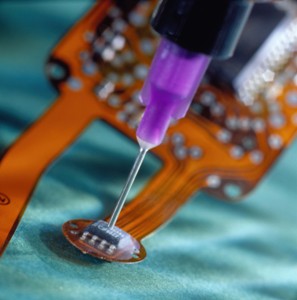The new DYMAX 9100 series of new light/moisture-cure encapsulants from adhesives specialists Intertronics is a selective range of products for protection of small areas of PCBs where sensitive chips or other devices can be encapsulated by a glob top process.
 Dymax Dual-Cure Encapsulants
Dymax Dual-Cure Encapsulants
In particular the DYMAX 9101, 9102 and 9103 now provide a rapid secondary moisture cure for shadowed areas. The additional curing process gives a more secure cure where the adhesive may flow under the encapsulated device. This could be a chip-on-board application where there is a need to lend mechanical support to fragile wire connections – also of course chip-on-flex, chip-on-glass and traditional wire bonding. Localised protection may thus be selectively provided to a particular area for vibration damping, structural integrity, mechanical protection or environmental protection reasons.
Dymax Dual-Cure 9101, 9102, and 9103 are resilient, chip-encapsulant materials designed with a UV/visible light cure and a very quick secondary ambient moisture-cure system, making them ideal for encapsulation applications where shadowed areas are present. These materials cure tack free after UV cure, so boards can be handled sooner with less potential for damage. The 9100 series rapid two-day moisture cure – compared with seven days typical with other systems – shortens the time for further handling as well as final testing and assembly.
These three new materials have varying viscosities of 7,000, 17,000, and 25,000 cP, to match the material creep and slump required of particular applications. This choice allows for performance and dispensing to be optimized with jet dispensable capability for more accurate placement and more efficient material usage. The cured materials are flexible, reducing stress to on board components. Unlike other encapsulants the 9100 series do not require refrigeration for transportation/storage of the uncured material, so no additional associated costs are incurred.
For further information please see www.intertronics.co.uk/encapsulants or visit their blog at www.adhere.uk.com – also see www.youtube.com/intertronicsadhere.